There are few topics in which ecceptions exceed standard features: Luftwaffe camouflage schemes is one of them. This article is created to clarify this topic, analyzing each one of the patterns applied on German aircraft during the Second World War.
German Air Force, or Luftwaffe, founded in 1935, adopted a considerable variety of camouflages for its aircraft. Starting with monochromatic paintings during the first months, in 1936 the first camouflage scheme appeared. At the beginning, this was applied on each type of aircraft. However, this use rapidly changed, introducing different colours and patterns depending on the aircraft role and its operational theatre.
Later, at the beginning of the Second Wolrd War, differentiation of mimetic patterns developed progressively. This lead to the appearence of several modification of the same camouflage scheme. As a consequence, observing original photos, it might be concluded that patterns were applied with an illusory randomness. On the contrary, this apparent randomness was actually ordered by periodic directives issued by the Ministry of the Air force (RLM, Reichsluftfahrtministerium).
That said; why does it seem so difficult to find any aircraft painted with the same camouflage pattern? The next paragraph should give you the answer.
Camouflage schemes application
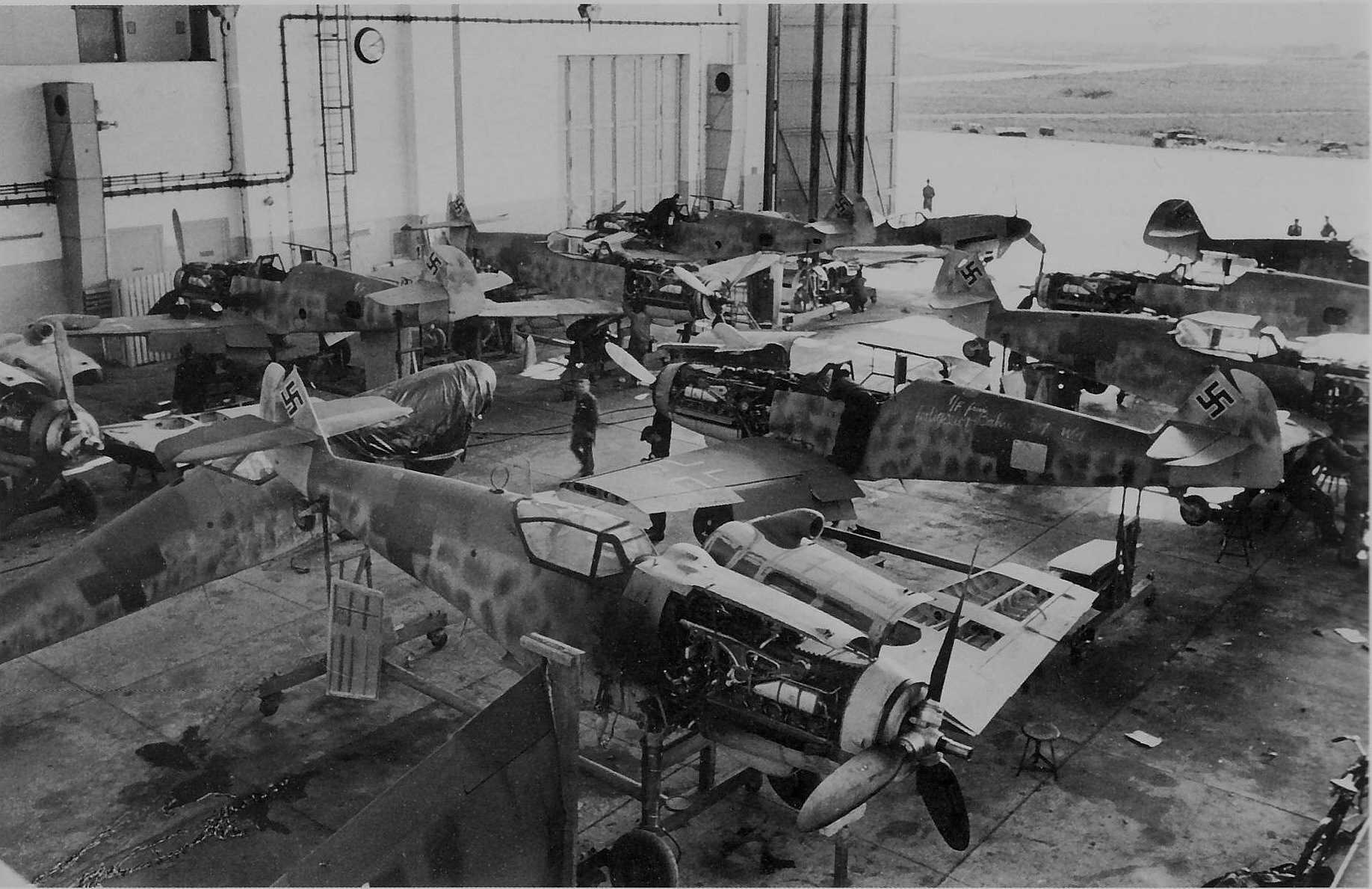
Messerschmitt Bf 109 G-6 assembly line at the Erla production plant. Regensburg, late 1944.
The livery shown by a Luftwaffe operational aircraft is the result of at least two painting stages. The first one, applied along the assembly line, provided for a primer, several layers of protective coat, camouflage, national insignas, serial number and Stammkennzeichen codes.
During this phase, the painting scheme was absolutely standardized and usually homogeneus among different production plants. Indeed, the application of camouflage was regulated by written documents provided with related illustration that limited (or better forbade) any possible variation of the liveries.
The decentralised aeronautical production system
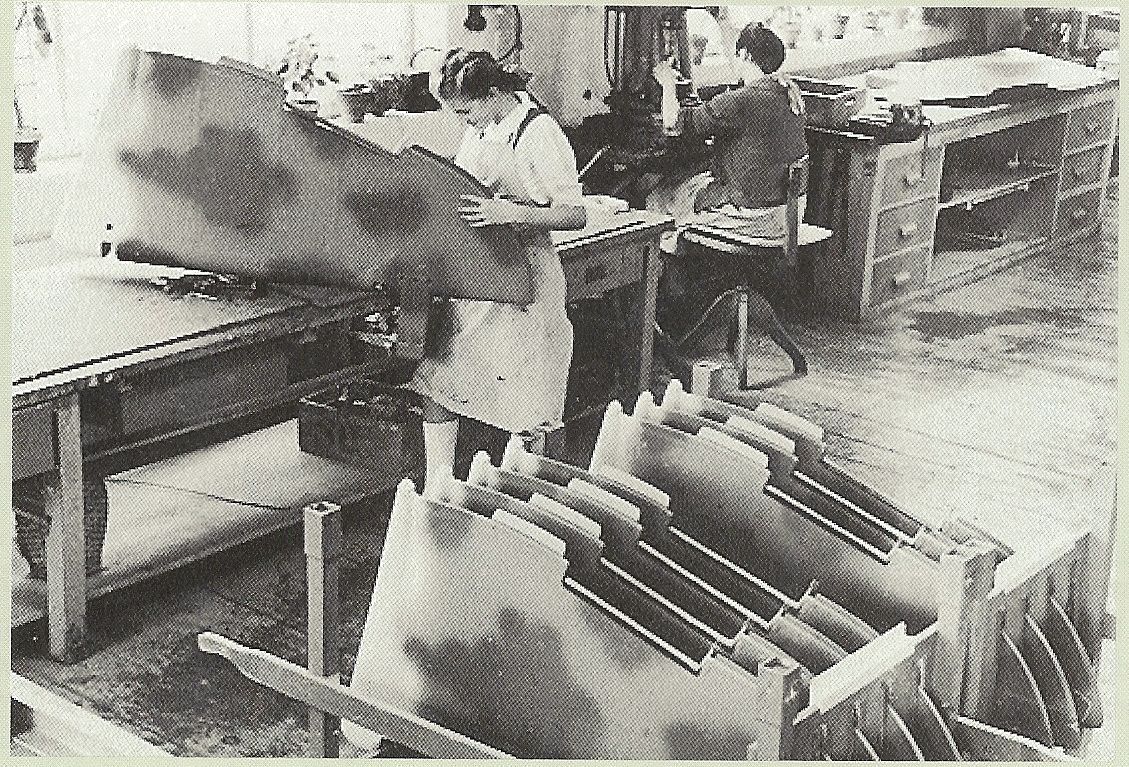
Two workers photographed while manufacturing Bf 109 K tail rudder. Here it is clearly vivisble how each component was pre-painted even before being assembled with the fuselage.
However, it is necessary to point out that the previously described standardisation gradually collapsed during the last three years of war. This was caused by the decentralisation of military production. As a consequence, various components were singularly manufactured and pre-painted in numerous minor facilities. Therefore, each already camouflaged component was transported to a main assembly plant where they were put together. Due to this production system, parts painted with different camouflage schemes could be assembled on the same aircraft. Coming across photographs of Me bf 109 Ks or Fw 190 Ds apparently composed of “mismatched” components is not uncommon. This feature is indeed the result of several different paintings applied over components belonging to the same aircraft.
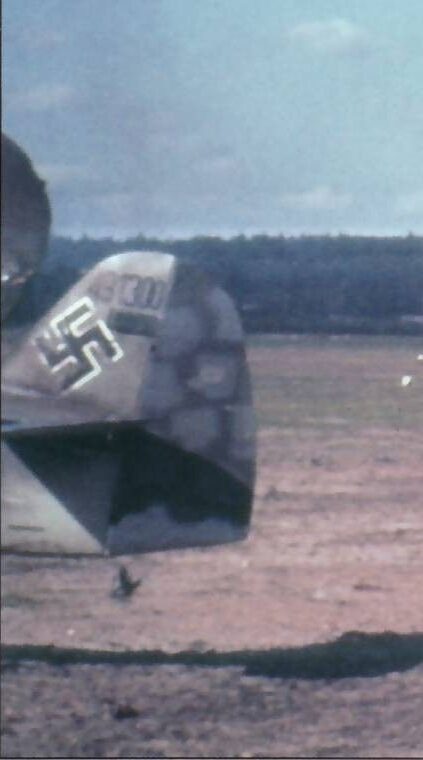
Detail of the tail of a Messerschmitt Bf 109 K or G, W.Nr. 431300. This photograph shows the apparent mismatched effect that affected the liveries of several late war aircraft.
Consequently, with the sole exception of differently painted parts assembled together, liveries variability was rather contained during this painting stage.
Second painting stage: operational airfields
The second painting stage all aircraft were subjected was applied directly at the operational airfields. This, at least theoretically, provided the removal of Stammkennzeichen, the application of the identificative number and the Verbandskennzeichen (with the exception of fighters and ground attack aircraft) and the possible addition of unit identification symbols. Practically, however, the livery as well was often altered.
Mottled patterns or irregular schemes were frequently applied over the aircraft surfaces painted in RLM 65 or RLM 76. The additional painting could include the same colours of the standard camouflage, or even different ones. Concerning this possibility, each unit had its own habit. That said, it is easy to understand how the actual number of possible camouflage schemes was extremely high.
Another circumstance in which aircraft liveries could be drastically modified was the conversion from daylight to night scheme or from summer to winter scheme. The two of them were regulated by directives such as the L.Dv. 521/1. However, conversions were not carried out in factories, but directly at the operational airfields. This factor increased the possible interpretations of the directives provided by the RLM.
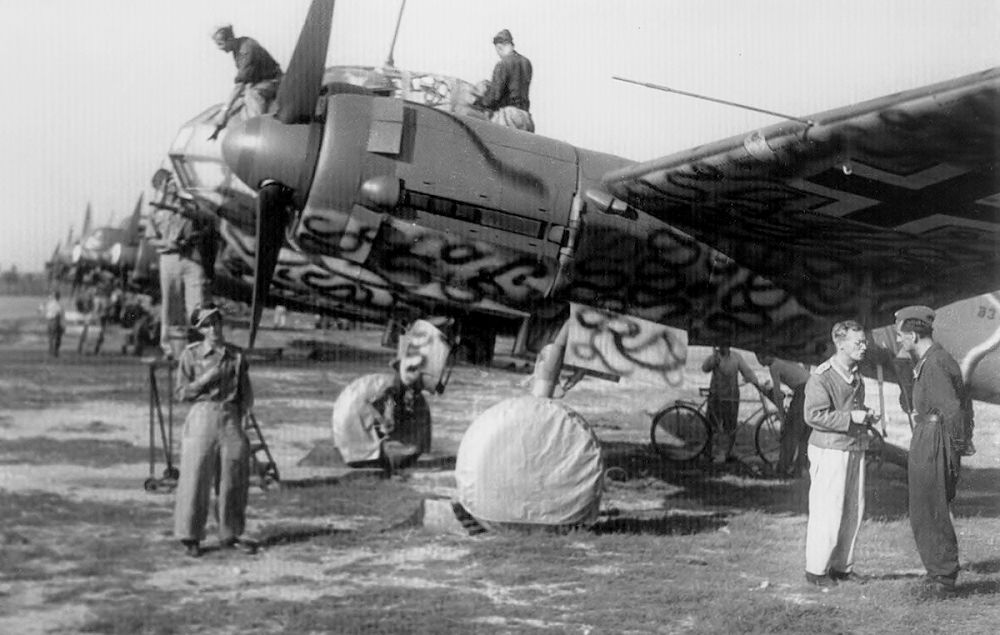
A Junkers Ju 88 A-4 coded B3+AM belonged to 4./KG 54 photographed at Catania, Italy, March 1943. This aircraft shows clear evidence of an additional painting applied on the lower surfaces of wings and fuselage.
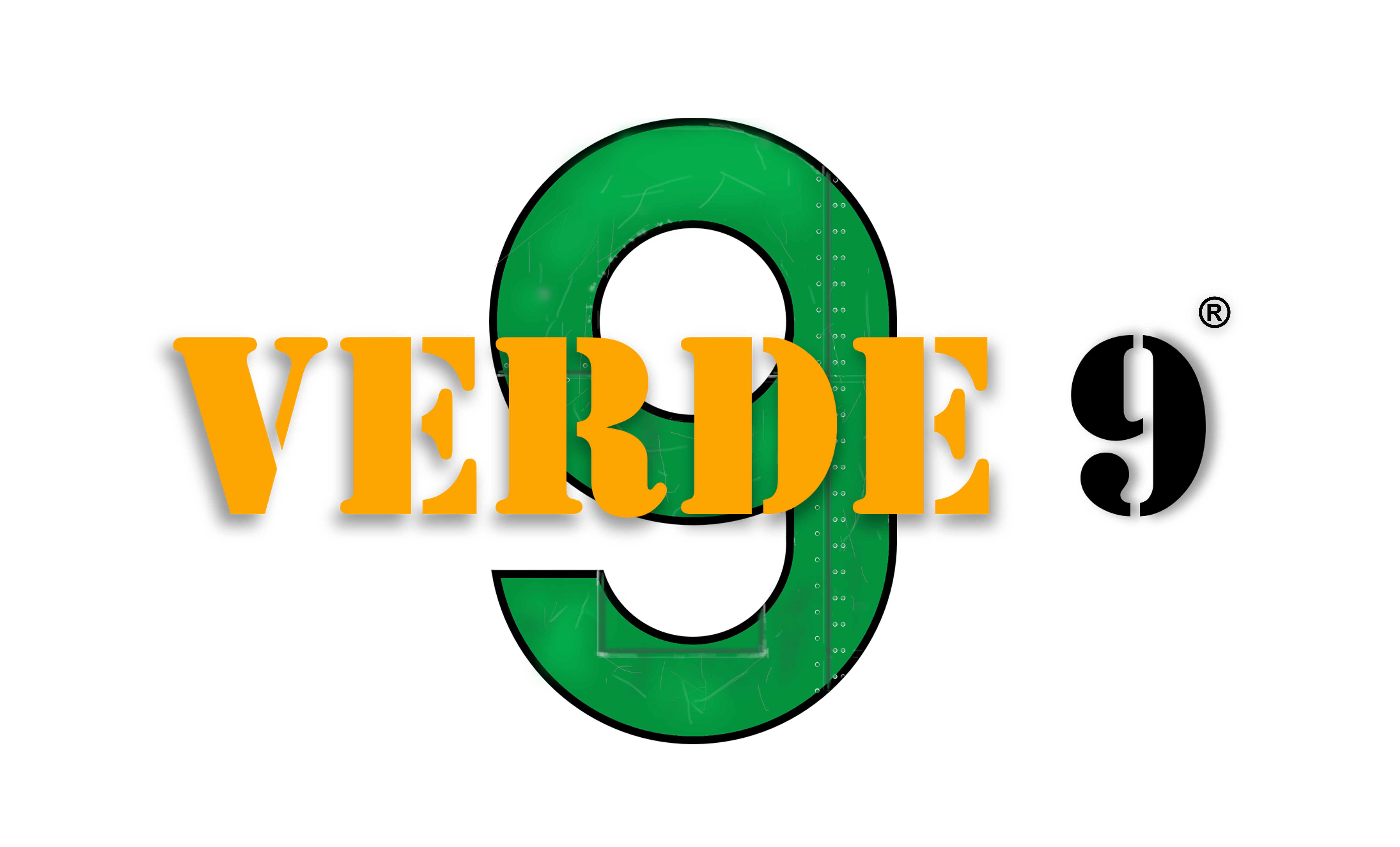

7 commenti
Allesandro,
With respect to the Me 410 “SI+K?”, (WNr.110288-110304), this is a re-built Me 210. I would argue that the machine’s uppersurface camouflage colours were RLM 75/77. The contrast between these two colours is high compared with low contrast between RLM 74/75.
Note that when two RLM colours are used for an upper surface camouflage pattern, the dark and light colours are located in the same position as specified in the respective machine’s Os-Liste. For example, if an Os-Liste calls for RLM 74/75, and the scheme is changed to RLM 75/77, the darker of the two colours (75) will replace the 74 and the lighter 77 replace the 75.
Keep up the good work – this is an excellent website!
Cheers,
David
Dear Mister Brown,
Thank you so much for your comment! I really appreciate readers’ impressions, in particular when they are as carefully documented as yours.
Talking about the Me 410 “SI+K?”, the contrast of the upper surfaces hues is definitely high as you pointed out. I had actually excluded the possibility of a 75/77 livery, since the only documented use of the RLM 77 is stated by the L.Dv.521/1, where it is intended for night aircraft insignia and not as a camouflage colour.
However, I agree with you: the lighter colour appears to be too bright to be RLM 74, unless we consider the case of a very intense illumination (that I would exclude).
Therefore, an RLM 75/77 scheme is definitely possible. The only issue I came across in my research about RLM 77 consists of a lack of documentation about any other usage apart from insignias. That is the reason why I am so prudent while talking about this particular hue.
If you agree, nevertheless, I would like to further discuss this topic, analyzing other examples, or even documents with you, as I think that your experience in this field is definitely vast.
I would like to thank you again for your kind comment and encouragement.
I await your answer with great interest!
Cheers,
Alessandro Orseniga
I’ve trying to find some information about a strange smell that my grandfather-in-law mentioned in his diaries. Here’s what he wrote: “During this last attack, three aircraft were shot down within sight and my father and I motored over to look at two of these which were comparatively intact. These were Junkers Ju 88, a new machine and a most modern and efficient bomber, fast and well armed. I will always remember the peculiar smell which pervaded the aircraft and this was always noticeable in all types of German aircraft throughout the war. I think that it was caused by the dope that they used in the camouflage paint.” I have no idea what he meant by dope, I may have read that word wrong. But do you have any ideas on this? Anything in the paint that could cause a strange smell?
Grazie mille
Dear Kath, thank you so much for reaching out!
I beg your pardon for having taken so long to give you an answer.
Reading the words of someone who actually lived through the war, like your grandfather-in-law, it is always very interesting to me, so thank you for sharing these lines of his memories.
With “dope” he is referring to a particular lacquer that was used to provide better mechanical properties to fabric-covered surfaces. However, since the aircraft he is describing, the Junkers Ju 88, but generally speaking the majority of World War II airplanes were, to a large extent, metallic machines, he is probably meaning a generic coating paint.
Anyway, this fact is really interesting, since your grandfather-in-law was not the only one who noticed it. I remember that Captain Eric Brown, in his book “Wings on my sleeve”, mentions the same feature talking about German aircraft interiors.
Unfortunately, far what concerns the exact compound that may have caused that smell, it is quite difficult to determine it, since the composition of some lacquers is still unkwnown. Paints adopted by Luftwaffe were generally based on synthetic resins, some of them contained nitrocellulose. These compounds (not to mention their harmfulness) undoubtedly have a pungent smell, and therefore might be the cause of what your grandfather-in-law has described.
I hope that I have been of some help. Should I ever came across further information, it would be a pleasure for me to let you know about it.
Please, feel free to write again.
Best regards,
Alessandro Orseniga
Alessandro,
If memory serves the odour is related to the hydraulic fluid used by the Germans. Captain Eric Brown stated this in one of his”From the Cockpit” Luftwaffe aircraft articles that appeared in Air International in the 1970s and 1980s. If I come across the specific one I will let you know.
Best,
David
Best,
David
What a fantastic article and with such superb graphics on that timeline; brilliant!
I eagerly await future parts; particularly on the desert camo schemes!
Adam
Dear Adam,
Thank you so much for your kind words! I will try to please your wish as soon as possible!
Best regards,
Alessandro